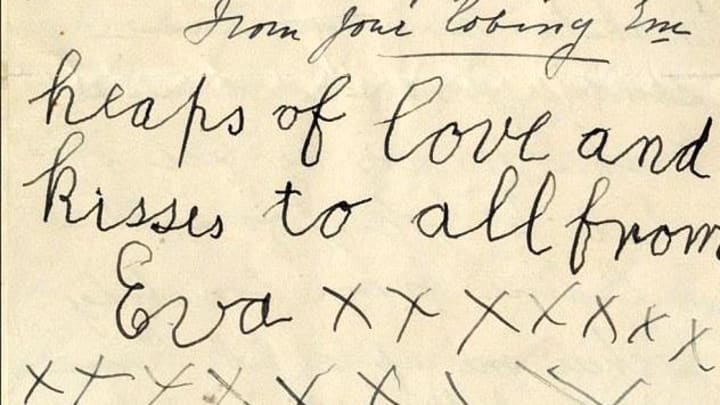Seven-year-old Eva Hart boarded the Titanic with her family on April 10, 1912, not knowing that her life was about to change forever. In her later years, she had the distinction of being one of the last living Titanic survivor with first-hand memories of the disaster. Here are six facts about Eva Hart’s role in history.
1. Eva Hart’s family planned to emigrate to Canada.
Before the fateful journey, the Harts lived in Ilford, a bustling community in East London. Eva’s father Benjamin wished to move to Winnipeg, Manitoba, where his brother already lived, and establish a drug store. But Eva’s mother Esther was opposed to the plan. Many decades later, Eva told an interviewer that “my mother was so upset … she was so desperately unhappy about the prospect of going, she had this premonition, a most unusual thing for her.”
2. A coal strike altered the Harts’ itinerary.
An ongoing coal workers’ strike upended the Harts’ plans, just as it did those of another long-lived Titanic survivor, Millvina Dean. The Harts had been scheduled to board the American Line steamship Philadelphia in Southampton, but were instead placed on the Titanic with other passengers from the vessel. The Harts had second-class tickets for the Titanic and paid a total of £26 and five shillings (about £2657 or $3490 today).
3. Eva Hart and her mother made it into a lifeboat.
Eva was sleeping when the Titanic collided with the iceberg at 11:40 p.m. on April 14, 1912. Her father rushed into their cabin and woke her and her mother, and then hustled them up to the boat deck toward the stern of the ship. He ensured that they boarded Lifeboat 14, then told Eva, “Hold mummy’s hand and be a good girl.” She never saw him again.
Lifeboat 14 was the fifth boat lowered from the Titanic, at about 1:30 a.m., and held roughly 40 people. The crew members in charge picked up several survivors from the water and redistributed the passengers among other lifeboats. Number 14 was brought aboard the rescue vessel Carpathia after 7 a.m.
4. Eva Hart had nightmares for years following the 'Titanic' sinking.
Eva returned with her mother to England and endured vivid recollections of the horrors she experienced. She told an interviewer in 1993, “I saw that ship sink … I saw it, I heard it, and nobody could possibly forget it.” She remembered the stars shining overhead and the terrible stillness of the scene broken up by the screams of survivors.
After her mother passed away in 1928, Hart decided to face her fears. She booked passage to Singapore by steamship, and locked herself in her cabin until she had overcome her terror.
5. Eva Hart spoke out against “grave robbers.”
After the Titanic's wreckage was discovered on the seabed of the Atlantic in 1985, Hart decried the efforts to recover its artifacts. She believed the wreck was a sacred grave site and argued against disturbing it. She called the salvage companies vying to own a piece of the legendary ship “fortune hunters, vultures, pirates, and grave robbers.”
At the same time, Hart was a special guest at many Titanic conventions and memorial events. Along with another long-lived survivor, Edith Brown Haisman, she unveiled a plaque commemorating the Titanic’s victims at London’s National Maritime Museum in 1995. Hart passed away the following year at age 91.
6. A letter written by Eva Hart’s mother sold for £119,000.
Esther Hart wrote a letter on Titanic stationery, dated “Sunday afternoon” (i.e., April 14, 1912), to her mother back in England. It is believed to be the only surviving letter from the voyage. Her husband Benjamin had placed it in his coat pocket to be mailed later, but when he loaded his family into the lifeboat, he gave the coat to his wife to keep her warm. At a 2014 auction, the item fetched £119,000, or about $200,000 at the time.
This article has been corrected to reflect that Eva Hart was one of the last Titanic survivors with first-hand memories and that the lifeboat was launched around 1:30 a.m.
